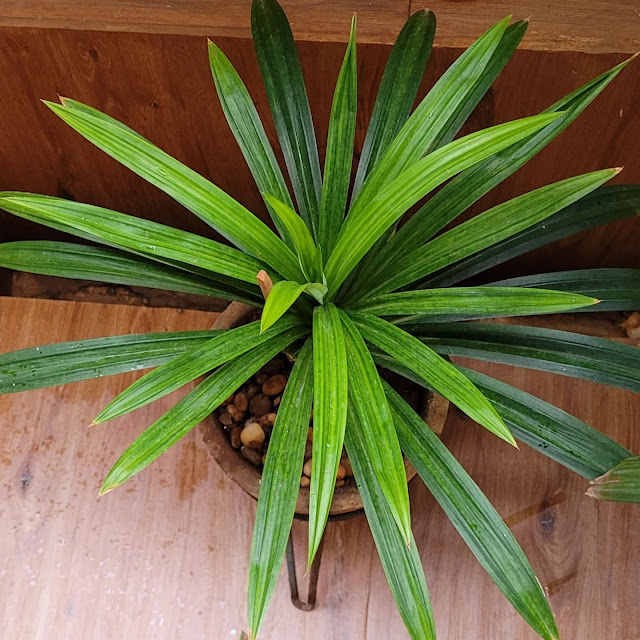
Pandan Plant is also known as Pandanus Amaryllifolius is a tropical plant that can be found in many parts of the world. This plant is used to clean the air because it has a strong scent that can remove pollutants from the atmosphere.
Pandan Plant (Pandanus Amaryllifolius) also helps to improve humidity levels, which can also help clean the air.
Not to be confused with the more well-known pandan cake, which is actually made of breadfruit, this Tropical Pandan Plant can help clean the air in your home and is growing quickly in popularity as an air purifier. Find out how this tropical plant works and what other benefits it could have for your health and indoor air quality!
History And Use Of Pandan plant
The pandan plant (Pandanus Amaryllifolius) is believed to originate from Southeast Asia, and it has been used in Asian cooking for centuries. The leaves of the pandan plant (Pandanus Amaryllifolius) are long and narrow, and they have a unique, sweet aroma.
Pandan Plant (Pandanus Amaryllifolius), is a subtropical plant that grows in warm climates around the world. The pandanus leaf and stem have an oily texture which makes it an excellent natural air purifier. When burned, the leaves produce a fragrant smoke that can clear indoor air of pollutants.
Pandan plant leafs are commonly used as a flavoring agent in Southeast Asian cuisine. The leaves can be used fresh, or they can be dried and ground into a powder. Pandan leaves are often used to flavor curries, rice dishes, and sweets.
Botanical Features
The pandan plant (Pandanus Amaryllifolius) leafs has antibacterial properties which make it perfect for cleaning surfaces and removing bacteria and other contaminants from the air. Simply burning pandanus leaves in a pot on your stovetop will create a pleasant odor that will help to clean your home of harmful gases and odors!
Pandan Plant (Pandanus amaryllifolius) is a plant that grows in warm climates all over the world. This plant has many botanical features that can help clean your air. Firstly, this plant has large leaves that can easily turn over and pull pollutants out of the air.
Additionally, the flowers of this plant produce a lot of pollen which can help distribute pollutants throughout the environment. Tthis plant is also high in antioxidants which can protect cells from damage caused by pollution.
Fragrance And Traditional Medicine
The Pandan Plant (Pandanus amaryllifolius), or screw pine, is a tropical plant native to the Indian Subcontinent and Southeast Asia. The pandan leaf has been used in traditional medicine for centuries to treat respiratory problems such as asthma and bronchitis. In recent years, researchers have found that the leaf extract can also be effective at cleaning air pollution.
Both the leaves and fruit of the Pandanus Amaryllifolius are rich in compounds that can break down pollutants such as carbon dioxide, nitrogen oxide, and ozone. The Pandan leaves contain linalool and nerolidol, which are both primary fragrances in plants. These fragrances interact with other chemicals in the atmosphere to form particles that can be removed by the lungs.
Studies have shown that exposure to air pollution can lead to increased rates of asthma and other respiratory problems. By using a plant like the pandan, it may be possible to reduce exposure to harmful pollutants without having negative effects on health.
Use Of Pandan In Different Countries

Did you know that Pandan is often used in Southeast Asia for cooking and baking. The leaves of the pandan plant (Pandanus Amaryllifolius) have a very strong, sweet aroma that is often compared to vanilla. In addition to its delicious smell, pandan leaves are also packed with nutrients.
They are high in antioxidants, which can help protect your body against disease. If you're looking for a new culinary challenge, why not try cooking with pandan leaves? You may be surprised at how tasty they are!
Pandan leaves are commonly used in Southeast Asian countries like Malaysia, Indonesia, and Thailand. They are often used to flavor rice dishes, curries, and desserts. Pandan leaves can also be used to make pandan extract, which is a popular ingredient in Southeast Asian cuisine.
In Malaysia, pandan leaves are often used to flavor nasi lemak, a popular rice dish. Nasi Lemak is made with coconut milk, pandan leaves, and chili peppers. It is often served with chicken or beef curry.
In Indonesia, pandan leaves are used to flavor many different dishes. One popular dish is Nasi Uduk, which is made with rice, coconut milk, and pandan leaves. Nasi Uduk is often served with chicken or beef stew.
In Thailand, pandan leaves are used to flavor many different desserts. One popular dessert is Khao Niao Mamuang, which is made with sticky rice, mangoes, and pandan extract.
In India its called Annapurna and and they use to aroma rice and pithas and in Banglades its called Pullao Patta and in Siri Lanka its called Rampe and they do use in many dishes for aroma along with curry leaves.
Pandan leaves can also be used to make tea. Pandan tea is said to have many health benefits, including aiding in digestion and helping to lower cholesterol levels.
Altough Pandan Plant leaves are a versatile ingredient that can be used in many different dishes. If you're looking for a new culinary adventure, why not try cooking with pandan leaves? You may be surprised at how delicious they are!
Pandan extract is available for purchase online and in some specialty stores. If you cannot find pandan extract, you can also use pandan essence, which is a concentrated form of pandan flavor. Pandan essence is typically used in baking, and it can be found in the baking aisle of most supermarkets.
Pandan leaves are a versatile ingredient that can be used in many different dishes. If you're looking for a new culinary adventure, why not try cooking with pandan leaves? You may be surprised at how delicious they are!
Fragrance And Traditional Medicine
Pandan leaves are known for their strong, sweet aroma. This aroma is caused by the presence of aromatic compounds called sesquiterpene lactones. Sesquiterpene lactones are also responsible for the plant's medicinal properties.
Pandan leaves have been used in traditional medicine for centuries. In Malaysia, pandan leaves are often used to treat indigestion and stomachache. The leaves are thought to help relieve gas and bloating.
Researchers have found that Pandan leaves have important minerals, vitamins and antioxidants that is known good for health pandan plant is a rich source of vitamin A they are also good for eye health that said to have anti-inflammatory properties. In Thailand, pandan leaves are often used to treat joint pain and stiffness.
Pandan Plant (Pandanus Amaryllifolius) Vitamins include:
- Riboflavin
- Niacin
- Beta-carotene
- Vitamin C
- Thiamin
For Arthritis & Joint Pains
Recent research has shown that oils made from pandan (Pandanus Amaryllifolius) extract are rich in a variety of phytochemicals, including those known to ease symptoms of arthritis. What's more is they can also help soothe headaches and earaches.
For Heart & Sugar
Pandan Plant (Pandanus Amaryllifolius) is also God gifted researchers discovered that a type of leaf called pandan had high amounts of carotenoids, a class of antioxidants. These are known to prevent the development of heart disease and atherosclerosis.
Some initial studies show that people who drink pandan tea after a meal have lower blood sugar levels than people who don't.
Air Freshener
Pandan leaves can also be used as an air freshener. The strong, sweet aroma of the leaves will help to freshen up any room. To use pandan leaves as an air freshener, simply place a few leaves in a bowl of water and place it in a room that you would like to freshen up. The leaves will release their fragrance into the air, and the room will smell great!
Pandan leaves are a versatile ingredient that can be used in many different ways. If you're looking for a new way to freshen up your home, why not try using pandan leaves? You may be surprised at how effective they are!
Pest control
Pandan leaves can also be used as a natural pest control method. The strong, sweet aroma of the leaves is thought to repel many different types of insects. To use pandan leaves as a pest control method, simply place a few leaves in a bowl of water and place it in an area that you would like to protect from pests. The leaves will release their fragrance into the air, and the pests will be repelled.
Pandan leaves are a versatile ingredient that can be used in many different ways. If you're looking for a natural pest control solution, why not try using pandan leaves? You may be surprised at how effective they are!
Conclusion
In conclusion, pandan leaves are a versatile ingredient that can be used in many different ways. Pandan Plant leaves are a versatile and useful ingredient that you should definitely try out!






Comments
Post a Comment